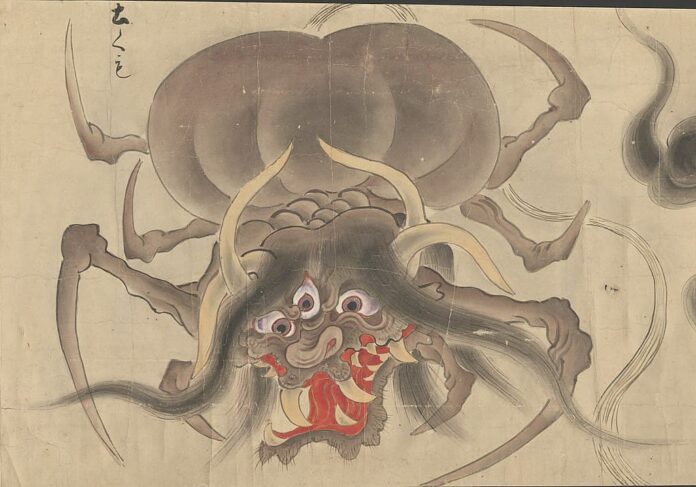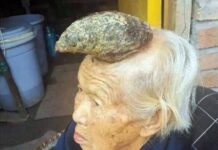Each culture has mysterious beings that they believe exist, and Yokai are the entities and spirits in Japan. In Japanese folklore, Yokai are not necessarily evil and horrible, some can also be friendly or helpful to humans also. One thing that all Yokai share is the spiritual or supernatural abilities that they possess, making them powerful in a certain way. There are many Yokai, but we are going to focus on the scary ones today because we love creepy stuff. Although many Yokai are the inspiration from folktales or the imagination of artists, they are quite entertaining in animations. Let’s take a look at 8 Japanese Yokai below and let me know which one you think is the most fascinating.
1Gashadokuro

Literally means “starving skeleton”, Gashadokuro are spirits that take the form of giant skeletons that are 15 times larger than humans. The bones of Gashadokuro are of those who died in battle or because of starvation without a proper burial. Some sources mentioned that Gashadokuro is also the bones of those who died in famine, plagues, or mass graves. This Yokai looks for vengeance on those who caused their death or neglected them, and the living in general. Gashadokuro will roam and grab or crush lone travelers who cross paths with it in the darkest hours of the night. Then it will bite off the victim’s head to drink the blood that shoots out of the person’s body.
When a Gashadokuro is near, you will hear the sound of loud ringing due to the rattling of the Yokai’s teeth. This is the only way that you can tell that there is a Gashadokuro around. You cannot see it or kill it because it possesses the powers of invisibility and indestructibility. Because this Yokai died with anger and pain, so it keeps hunting its prey until its anger is no longer there. Then the bones will crumple, causing the Gashadokuro to collapse. Such abominations are rare in present days more than in the old days because famine and wars are not common anymore.
2Kappa

A kappa, which means river child, is an amphibious demon or imp from Japanese folklore. Kappa is one of the most well-known Yokai, appearing in books and even modern-day anime movies. Look similar to a frog, these beings have a scaly skin, webbed hands and feet, and a turtle-like carapace on their backs. Kappas are green in color, and it has a depression on their head known as a dish that retains water. This dish is the source of a kappa’s power, and it is unable to move or will die if the dish dries up. Even with a size of a boy, kappas are excellent swimmers and physically stronger than a grown man. As aquatic humanoids, kappas inhabit and thrive in rivers and streams all over Japan. Adult kappas are solitary, but it is common for them to befriend humans and other yokai.
Kappas are proud and stubborn, but they are fiercely honorable because they never break promises that they make. Another interesting thing about them is that kappas are one of the few yokai that are able to learn human languages. This is why they are able to befriend and share their knowledge about medicine with humans. Their most favorite food is cucumbers, and it is not uncommon to see offerings of cucumbers in Shinto. Many people feared kappas because the mischievous ones often assault humans in the water and feed on raw innards from the human anus. When there are violent kappas, there are warning signs to let people know that the lakes or rivers are dangerous. These convulsive kappas may attack animals and humans for no reason, bite or drown the victims, or rape swimming women. Apart from those, many kappas are very friendly and helpful to humans.
3Jikininki

Human-eating ghosts or Jikininki are the spirits of greedy, impious, or selfish individuals who are cursed after death. When a person (mostly priests) performs evil deeds that corrupt his soul, becomes a Jikininki when he dies. Their afterlife fate is to seek out and eat human corpses while appearing as ordinary humans with monstrous features. A Jikininki has sharp pointed teeth that they use to peel the flesh off of the bodies of the dead. These Yokai live in abandoned temples or old ruins near villages, but they avoid excessive contact with humans. Despite corpses being their only source of meal, they do not find pleasure in eating the dead at all. Jikininki also do not enjoy their existence because they remain just to fulfill their curse.
4Mikoshi Nyudo

Mikoshi Nyudo is a fearsome Yokai that roams on bridges, roads, and streets at night waiting to ambush lone travelers. At first, Mikoshi Nyudo appears to be a harmless monk or priest that looks just like an ordinary person. When the victim walks closer, Mikoshi Nyudo suddenly grows abnormally tall and extends his next while growing long claws and hair. Most of the time, the person falls as soon as the person raises his eyes to look upon a Mikoshi Nyudo. Then this monster lunges forward and bites the victim’s throat and kills him.
Even if the person ignores them and walks away, Mikoshi Nyudo will still kill him with bamboo branches or spears. The only possible way to escape is to show no fear. Do so by looking from its head down to its feet, rather than starting at the feet and looking up. If done properly, the giant’s power to grow will be sapped so he will stop growing. Then tell the yokai, “You lost! I anticipated your trick!” to cause it to vanish in anger, leaving the traveler to pass safely along.
5Nomori

Meaning wilderness guardian, Nomori is a large serpentine yokai that lives deep in mountain forests. It has a thick and barrel-like body that is around 3 meters long that it uses to kill its prey by constriction. A Nomori has 6 legs to aid stability during hunting and killing, and there are 6 toes on each foot. This yokai lives far away from human settlements so it is rare to come across or see one. Only people who went deep into the mountain forests to gather firewood would meet this yokai. If they are unfortunate, they would end up being the serpent’s prey. For those who are strong enough to fight it off, they would live to tell the tale. Rumors have it that those who killed this yokai may have some sort of curse cast upon them. Some curses are so serious they cost the person’s life.
6Onihitokuchi

This is one of the scariest yokai in Japanese folklore, and its name means “one bite from Oni”. It also goes by another name Kamikakushi which means “spirited away”. Onihitokuchi is a very big demon with one eye who kills and eats humans. Back in Heian Period, people put the blame on Onihitokuchi when a person is missing. Sometimes the victims came back many years later, profoundly changed by the traumatic experience. Meanwhile, some victims never returned so the villagers believed that it was an Onihitokuchi who ate or took those victims.
7Omukade

This giant centipede is one of the most famous yokai in Japanese mythology who also appears in modern days anime movies. Omukade had a dark and enormous body with bright orange legs and heads which is the cousin of the present-day Chinese Red-Headed centipede. The exoskeleton of this giant centipede was so tough that no weaponry could pierce through it. It was a highly aggressive and vicious yokai that lived in mountains near Lake Biwa, Shiga Prefecture. One bite from Omukade is painful and venomous enough to cause a person to die before its devouring time. However, its only weakness was human saliva which was toxic to these giant centipedes. The way to slay this demon was to coat weapons in saliva so that they could slice through its body.
8Tsuchigumo

This spider-like yokai from Japanese folklore was a huge spider that eat any animal and human it could trap. Tsuchigumo or Purse Web Spiders are found all over Japanese islands and probably throughout the world. When it lived long enough, it could transform into yokai and grow into a monstrous size. These demon spiders lived in caves, forests, mountains, and rural areas where they built homes in silk tubes. Tsuchigumo relied on illusion and trickery with the help of their sticky web to capture prey. This yokai appears in Japanese arts and scrolls since the 12th century as giant monster spiders that attacked and tricked humans. There is also a similar yokai called Umigumo that attacked people by sending out strings from its mouth. Either way, both of them were very dangerous yokai in Japanese folklore and mythology.
Related Post: Weird Folklore Creatures In Japan




